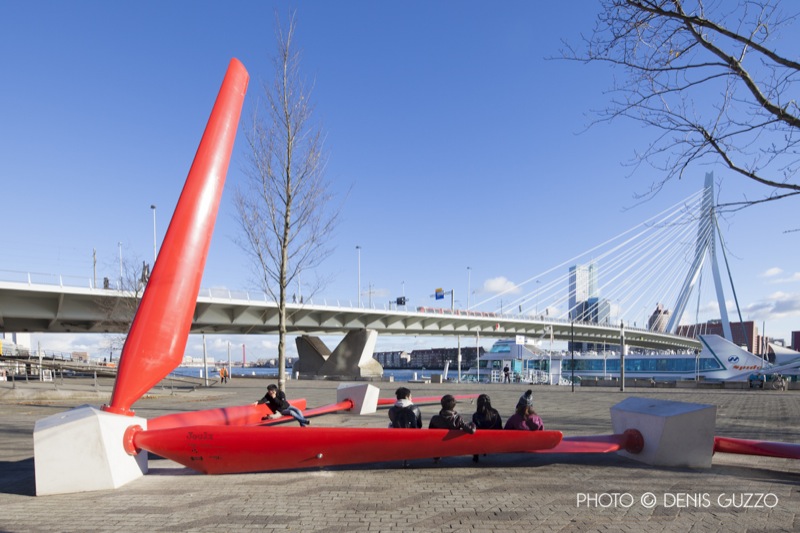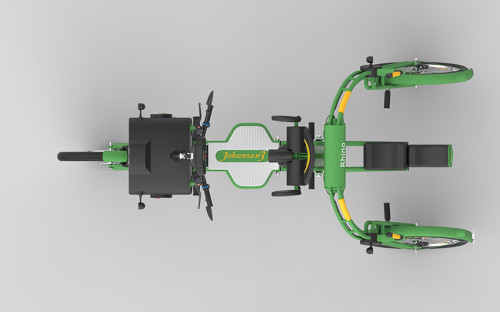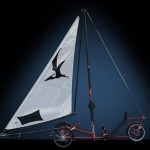You could power a ferris wheel with pedals and cranks — but these guys add gravity & guts to the power mix. The human powered ferris wheel. Picture credit: Dirty Wall Project. Thanks to Giuliana Fornaciari.
A World Made of Rotor Blades
Almost a quarter of a million windmills worldwide will need to be replaced by 2030. The rotor blades are made of valuable composite materials that are difficult to recover at the end of their energy generating life. New generation rotor blades made of glass or carbon fibre composite material have average lifespans of between 10 and 25 years. Recycling of glass fibre composite is possible though complex. Recycling of the more highly valued carbon fibre composite is currently impossible. In many EU countries landfill of carbon composites is now prohibited. Thus, many rotor blades at the end of their wind turbine life are currently shredded and incinerated. At current growth rates, by 2034, there will be about 225,000 tonnes of rotor blade composite material produced annually, worldwide.
The Dutch firm Superuse Studios has found a solution to the growing mountains of waste generated by the wind industry: making use of end-of-life rotor blades in design and architecture. The realised projects demonstrate the technical applications and potential for blade made designs and architecture. In their second life as design and architectural elements, rotor blades could be used for a further 50-100 years, or more. Blade made designs are durable, iconic, compete economically, and reduce the ecological footprint of projects in which they are used. [Read more…]
Japanese Joinery
 “Japanese carpentry group Kobayashi Kenkou carefully demonstrates the fascinating way in which highly durable buildings are constructed with traditional methods of joining the wood with intricate cuts and interlocking plugs instead of metal nails. The fine planing and perfect fit of each interlocking piece of wood is a testament to the craftsmanship of the carpenters.”
“Japanese carpentry group Kobayashi Kenkou carefully demonstrates the fascinating way in which highly durable buildings are constructed with traditional methods of joining the wood with intricate cuts and interlocking plugs instead of metal nails. The fine planing and perfect fit of each interlocking piece of wood is a testament to the craftsmanship of the carpenters.”
See them in action. Via The Shelter Blog.
A Scooter for Everyone
The Johanson3 is a stable three-wheeler, with the driver leaning back rather than sitting (though sitting is an option). Feet rest on a plate, and pressing down on that plate creates a lean on the front wheel, turning the vehicle while the rear wheels remain solidly on the ground.
That makes for easy on-and off, especially for those who – owing to age, injury, or fashion choice (“skirts, saris, djellabas, and kimonos” are accommodated, according to Johanson3) – cannot throw a leg over a bicycle seat. Various models accommodate single riders or as many as three adults plus two kids, and can haul up to 660lbs of flesh and cargo. Read more: The J3, a trike that hauls freight, spares frocks.
The Johanson3 is available for pre-order and costs $3,150 – $3,900.
The Merits of Obsolete Technology
 “Sales of books are eclipsing digital alternatives, while vinyl records, Polaroid cameras and even simple mobile phones are enjoying a resurgence… The appeal is only partly faddishness. For the old phones actually do what phones used to do, which is to make and receive phone calls, without depositing your whole life in cyberspace where it can be stolen and used to embarrass you before the entire world. According to the New York Times, one of the main attractions of the retro-phone for celebrities is that it helps keep their secrets safe. And, as rocker Iggy Pop says, “You can drop it and it doesn’t break.”
“Sales of books are eclipsing digital alternatives, while vinyl records, Polaroid cameras and even simple mobile phones are enjoying a resurgence… The appeal is only partly faddishness. For the old phones actually do what phones used to do, which is to make and receive phone calls, without depositing your whole life in cyberspace where it can be stolen and used to embarrass you before the entire world. According to the New York Times, one of the main attractions of the retro-phone for celebrities is that it helps keep their secrets safe. And, as rocker Iggy Pop says, “You can drop it and it doesn’t break.”
“Even typewriters are bouncing back. Spooked by the WikiLeaks and Edward Snowden affairs, intelligence agencies and political groups are reportedly returning to Cold War technology to keep their secrets safe. The glamour is back, too. Movie star Tom Hanks recently published a “love letter” to the typewriter, declaring: “The tactile pleasure of typing is incomparable… there is a sheer physical pleasure to typing.” Dr Mike Evans, a theoretical physicist at York University, believes that the appeal of high-technology is being undone by its constant quest for what he calls “sterile perfection”…”
Read more: Why low-tech living is back.








